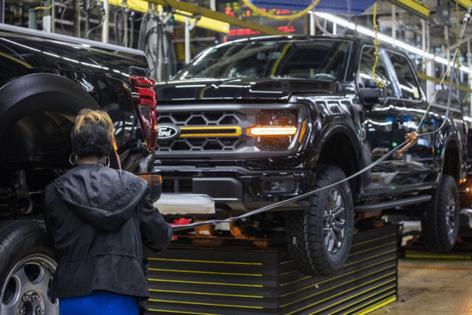Feds reject auto industry plea, keep automatic emergency braking rule intact
Published in News & Features
WASHINGTON — A new federal regulation requiring automakers to install automatic emergency braking technology in all new consumer vehicles by 2029 will remain in place despite complaints from the auto industry.
The National Traffic Highway Safety Administration said Monday it would make minor changes to the AEB rule, which was finalized in April, but preserve its most important tenets. Safety groups cheered the move.
"AEB saves lives and prevents crashes, and NHTSA's decision to move forward without delay is a big win for the safety of everyone on our roads,” said Cooper Lohr, senior policy analyst for transportation and safety at Consumer Reports. "Now it's time for automakers to accept the new rule as it stands and focus on rolling out more advanced versions of this technology across their fleets."
As is often the case, the rule put the auto industry at odds with federal regulators demanding life-saving but costly technology in light-duty vehicles. The decision to keep the rule intact comes five months after the nation's top automotive lobbying group asked NHTSA to reconsider the rule, with the group's leader calling it "practically impossible."
The Alliance for Automotive innovation, which represents all major U.S. automakers except for Tesla Inc., has already asked President-elect Donald Trump to re-examine the rule.
“What a waste. A 10-year partnership with policymakers that put this lifesaving automotive technology in almost all new vehicles was just tossed aside," John Bozzella, president and CEO of the alliance, said in a Monday statement.
“Wrong on the merits. Wrong on the science," he added. “Really a disastrous decision by the nation’s top traffic safety regulator that will endlessly — and unnecessarily — frustrate drivers; will make vehicles more expensive and at the end of the day … won’t really improve driver or pedestrian safety.”
The group also pointed to a June letter it sent to Congress and NHTSA.
The lobbying group said in the letter that the government "vastly" underestimated the compliance cost for automakers and warned that the regulations require automatic braking that will occur too far in advance of what drivers are typically used to, which would "likely" cause more collisions.
In its letter, the alliance complained in particular that "NHTSA’s new standard requires all cars be able to stop and avoid contact with a vehicle in front of them up to 62 miles per hour and that the systems must detect pedestrians in both daylight and darkness.' The standard also 'requires that the system apply the brakes automatically up to 90 mph when a collision with a lead vehicle is imminent, and up to 45 mph when a pedestrian is detected.'"
Road safety groups praised NHTSA for rejecting most of the industry's petitions for changes. A coalition of 34 organizations, including advocates and insurance companies, wrote their own letter the following month urging NHTSA to remain steadfast in implementing the rule.
"According to NHTSA, requiring AEB on light vehicles will save hundreds of lives and prevent thousands of injuries annually at a time when the carnage and expense borne from crashes on our roadways are at historic highs," Cathy Chase, president of Advocates for Highway and Auto Safety, said in a Monday statement.
She added: "NHTSA has done its job by putting safety first, and needless pain and suffering caused by preventable motor vehicle crashes will be averted because of this action."
Chase also cheered a separate NHTSA announcement Monday about continued declines in roadway fatalities, but she said conditions were still "catastrophic." Traffic deaths remain above pre-pandemic levels, according to NHTSA data.
Responding to an inquiry from The Detroit News, NHTSA provided a statement on its AEB rule actions.
"Earlier this year, NHTSA issued a new Federal Motor Vehicle Safety Standard that requires automatic emergency braking and pedestrian automatic emergency braking in all new passenger cars and light trucks beginning in September 2029," the agency said in an email. "This new requirement will save lives — at least 360 lives a year — and prevent at least 24,000 injuries. By requiring AEB systems, the agency is helping to address the crisis of fatalities on our roadways."
It continued: "Subsequent to the rule’s publication in April, the agency received several petitions for reconsideration. NHTSA today clarified technical requirements applicable to forward collision warning visual signals and audio signals, corrected an error in the test scenario for an obstructed pedestrian crossing the road, and removed superfluous language from the performance test requirement for lead vehicle AEB. Today’s notice denies all other requests in the petitions. The effective date for the rule remains September 2029."
Congress previously directed NHTSA, which is part of the Department of Transportation, to develop the new AEB rules as part of the 2022 Bipartisan Infrastructure Law passed under President Joe Biden.
Before that, in 2016, a group of government and industry groups established a voluntary commitment to make AEB technology standard on nearly all new vehicles. That group included NHTSA, the nonprofit Insurance Institute for Highway Safety, the nonprofit Consumer Reports, and automakers.
By 2023, according to the Insurance Institute for Highway Safety, 20 automakers — including Ford Motor Co., General Motors Co. and Stellantis NV — adopted the voluntary standard and installed AEB on 95% or more of their new light-duty vehicles.
Bozzella, of the industry alliance, lamented NHTSA going above and beyond that standard in its final AEB rule.
"Beyond the physics and the impracticability of the AEB rule, this episode points to the breakdown of a deliberative rulemaking process at the country’s top traffic safety watchdog," he wrote in June.
Bozzella added: "(A)fter a decade of shared and substantive work on AEB and a billion dollars invested, NHTSA inexplicably changed course and issued a rule that automakers indicated was not feasible with widely used braking technologies."
_____
©2024 The Detroit News. Visit detroitnews.com. Distributed by Tribune Content Agency, LLC.







Comments